MICROSCOPE-ANTIQUES.COM © 2013-15.
VERTICAL ILLUMINATORS AND RELATED EPISCOPIC APPARATUS
HISTORY OF ILLUMINATION OF OPAQUE OBJECTS:
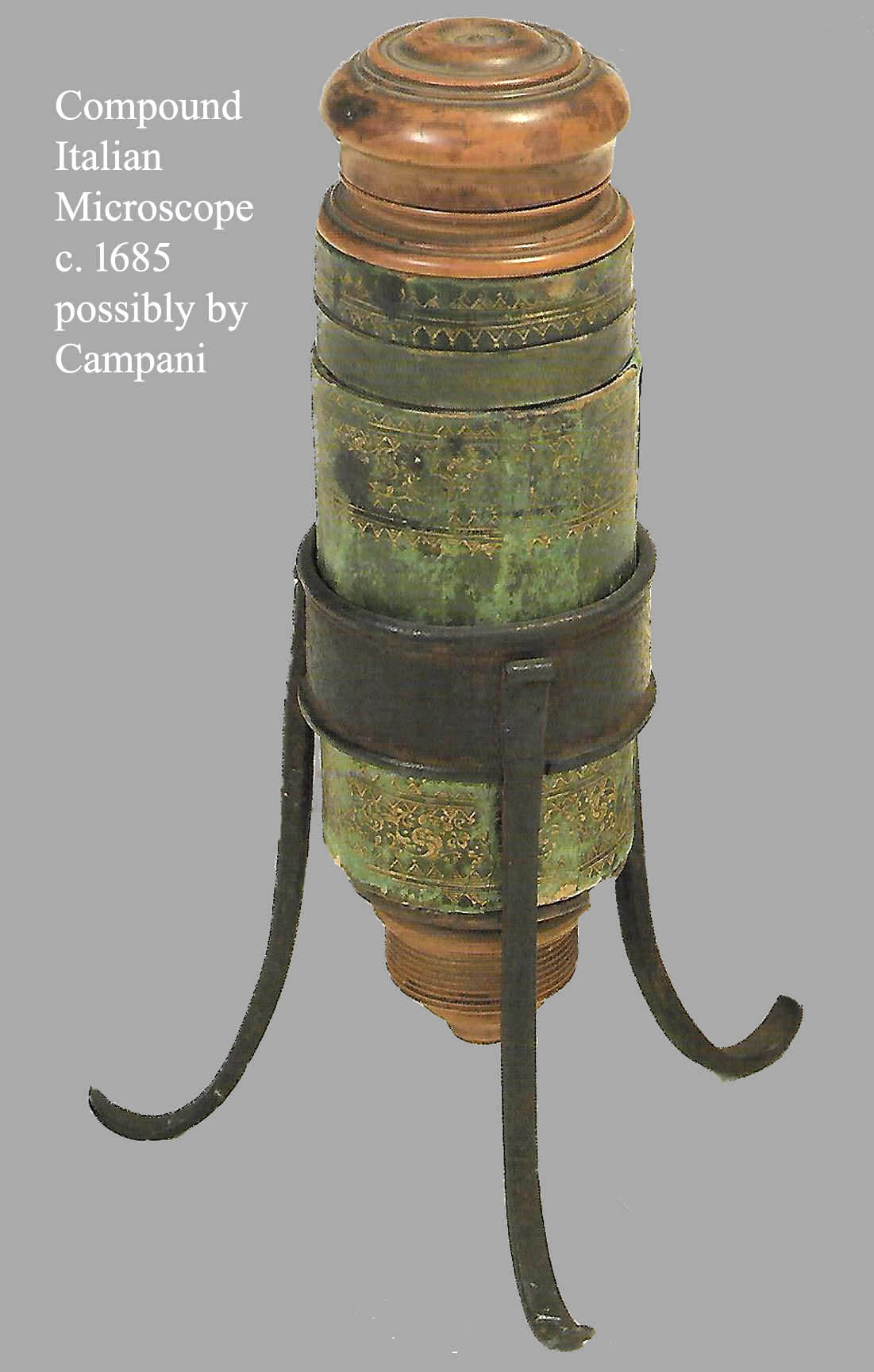 In order to visualize an opaque specimen in a microscope, it must be illuminated from above, rather than below. This kind of illumination can be accomplished several ways. The simplest and earliest method was simply illumination from the side of the object. This was how objects were originally viewed with, e.g. tripod microscopes, until the practice of using transmitted light was used. This is adequate with objectives of long focal length and low power, that is, 10X and lower power objectives, which with a 10X eyepiece provides a maximum magnification of about 100X, however as the power increases (and focal length decreases), it becomes more and more difficult to uniformly illuminate a specimen with ambient or even directed light.
In order to visualize an opaque specimen in a microscope, it must be illuminated from above, rather than below. This kind of illumination can be accomplished several ways. The simplest and earliest method was simply illumination from the side of the object. This was how objects were originally viewed with, e.g. tripod microscopes, until the practice of using transmitted light was used. This is adequate with objectives of long focal length and low power, that is, 10X and lower power objectives, which with a 10X eyepiece provides a maximum magnification of about 100X, however as the power increases (and focal length decreases), it becomes more and more difficult to uniformly illuminate a specimen with ambient or even directed light.
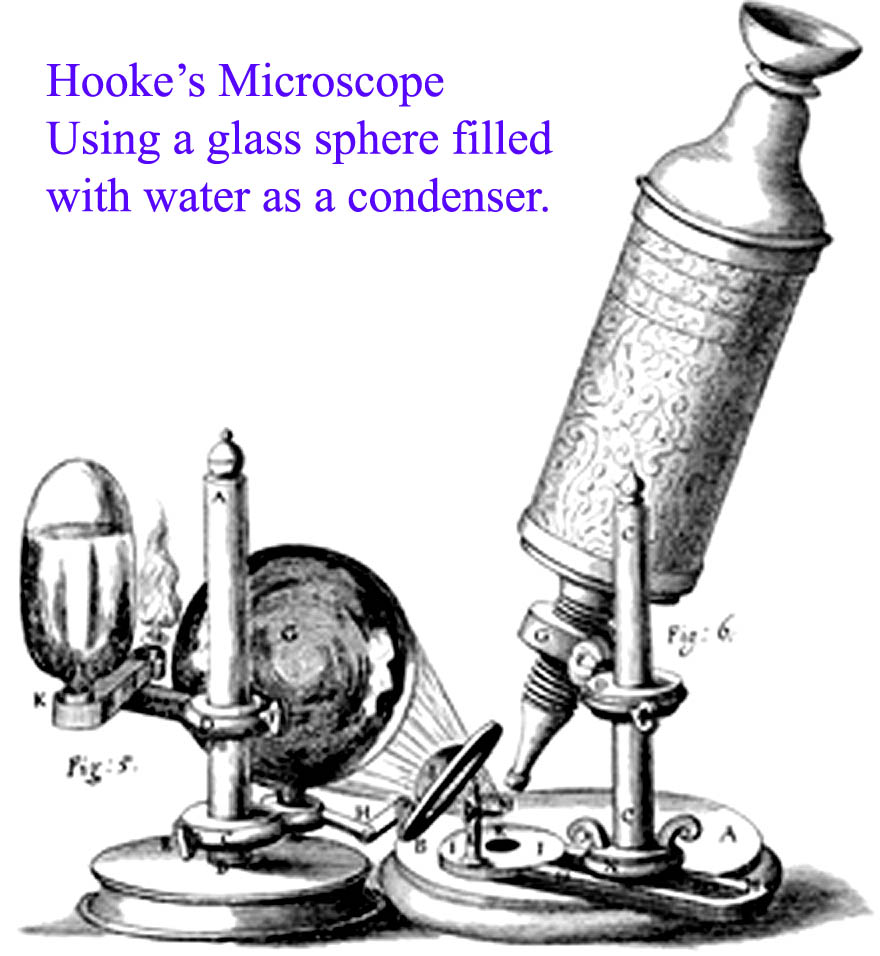 A lens between the light source and the object being studied can be used to concentrate the light. Robert Hooke was one of the first to use this method. He used a hollow sphere of glass filled with water and another planoconvex lens; this lens became knowns as a bullseye condenser.
A lens between the light source and the object being studied can be used to concentrate the light. Robert Hooke was one of the first to use this method. He used a hollow sphere of glass filled with water and another planoconvex lens; this lens became knowns as a bullseye condenser.
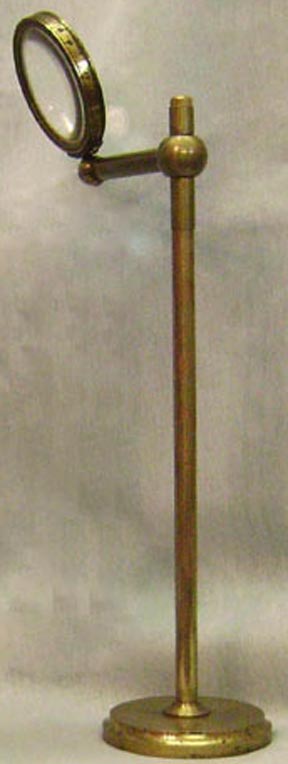 The 'bullseye' condenser, a large diameter plano-convex lens was in use for this purpose from the late 1700's onward. It could be supplied as a stand-alone lens as a 'bench' condenser, or when smaller, attached directly to the microscope via the stage, a ring around the optical tube or an extension rod attached to the limb.
The 'bullseye' condenser, a large diameter plano-convex lens was in use for this purpose from the late 1700's onward. It could be supplied as a stand-alone lens as a 'bench' condenser, or when smaller, attached directly to the microscope via the stage, a ring around the optical tube or an extension rod attached to the limb.
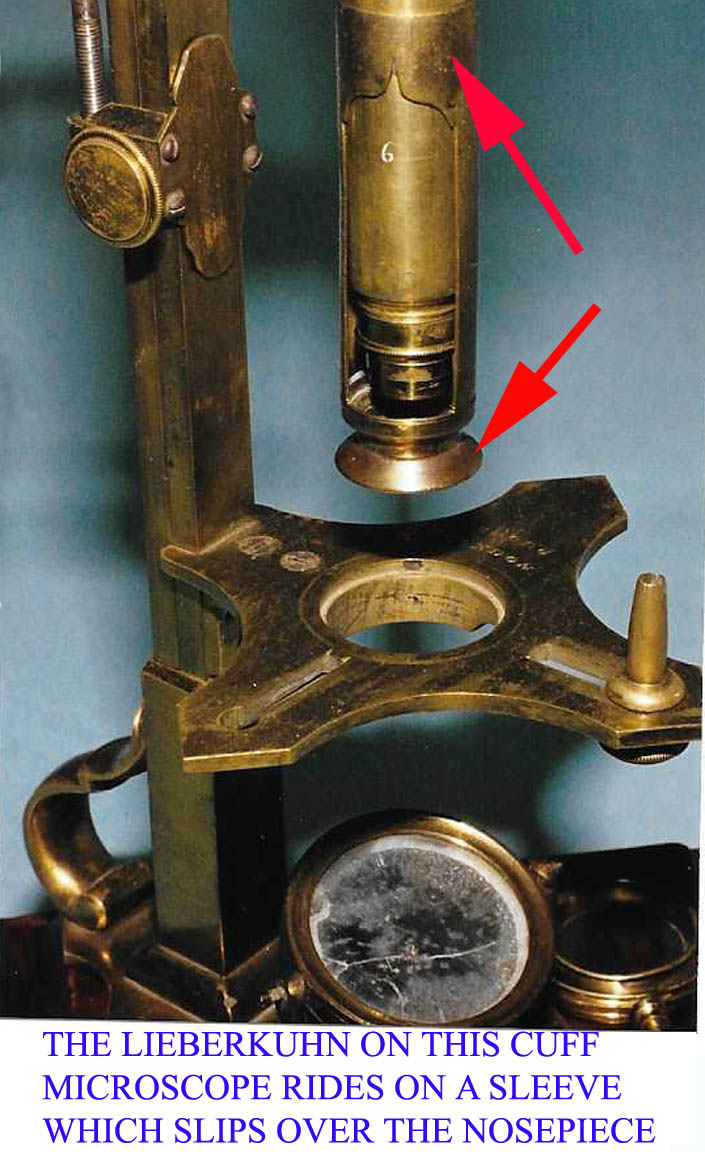
 With moderate powers, something more than an ordinary light source from above or the side is needed. The first attempt to do this was with the use of a Lieberkuhn reflector, initially suggested by Descartes, but first known to be used on a microscope by Van Leewoenhoek about 1670, and Pierre Van Musshenbroek, as pictured in his Essai de Physique published in 1739. Although this type of reflector continued to be used by Van Leeuwoenhoek in the 2nd quarter of the 18th century, it was reintroduced and popularized in the mid to late 1700's by Johann Lieberkuhn, hence his name became associated with the device. It was soon provided with most models of pre-achromatic microscopes such as the Culpeper type,Cuff type, etc. With the development of the achromatic microscope, Lieberkuhns continued to be supplied, usually purpose-made for each objective. With this device, the light source from beyond the object passes around it and is reflected back down upon it by a polished mirrored parabolic surface that surrounds the objective. The chief limitation of this technique is that the object must be small enough to allow the light to pass around it, and this is often not the case, especially for metal samples. Once brass nosepieces became common, removeable Lieberkuhn reflectors were made to fit around the nosepiece, with the reflecting portion sitting in front of the objective. As time passed, it was recognized that different sizes and curvatures were useful for different magnifications; higher power objectives required a Lieberkuhn of smaller diameter and lesser curvature. With the advent of achromatic objectives in the 1840's individual Lieberkuhns were often supplied for each objective, fitting over each objective itself rather than the nosepiece above.
With moderate powers, something more than an ordinary light source from above or the side is needed. The first attempt to do this was with the use of a Lieberkuhn reflector, initially suggested by Descartes, but first known to be used on a microscope by Van Leewoenhoek about 1670, and Pierre Van Musshenbroek, as pictured in his Essai de Physique published in 1739. Although this type of reflector continued to be used by Van Leeuwoenhoek in the 2nd quarter of the 18th century, it was reintroduced and popularized in the mid to late 1700's by Johann Lieberkuhn, hence his name became associated with the device. It was soon provided with most models of pre-achromatic microscopes such as the Culpeper type,Cuff type, etc. With the development of the achromatic microscope, Lieberkuhns continued to be supplied, usually purpose-made for each objective. With this device, the light source from beyond the object passes around it and is reflected back down upon it by a polished mirrored parabolic surface that surrounds the objective. The chief limitation of this technique is that the object must be small enough to allow the light to pass around it, and this is often not the case, especially for metal samples. Once brass nosepieces became common, removeable Lieberkuhn reflectors were made to fit around the nosepiece, with the reflecting portion sitting in front of the objective. As time passed, it was recognized that different sizes and curvatures were useful for different magnifications; higher power objectives required a Lieberkuhn of smaller diameter and lesser curvature. With the advent of achromatic objectives in the 1840's individual Lieberkuhns were often supplied for each objective, fitting over each objective itself rather than the nosepiece above.
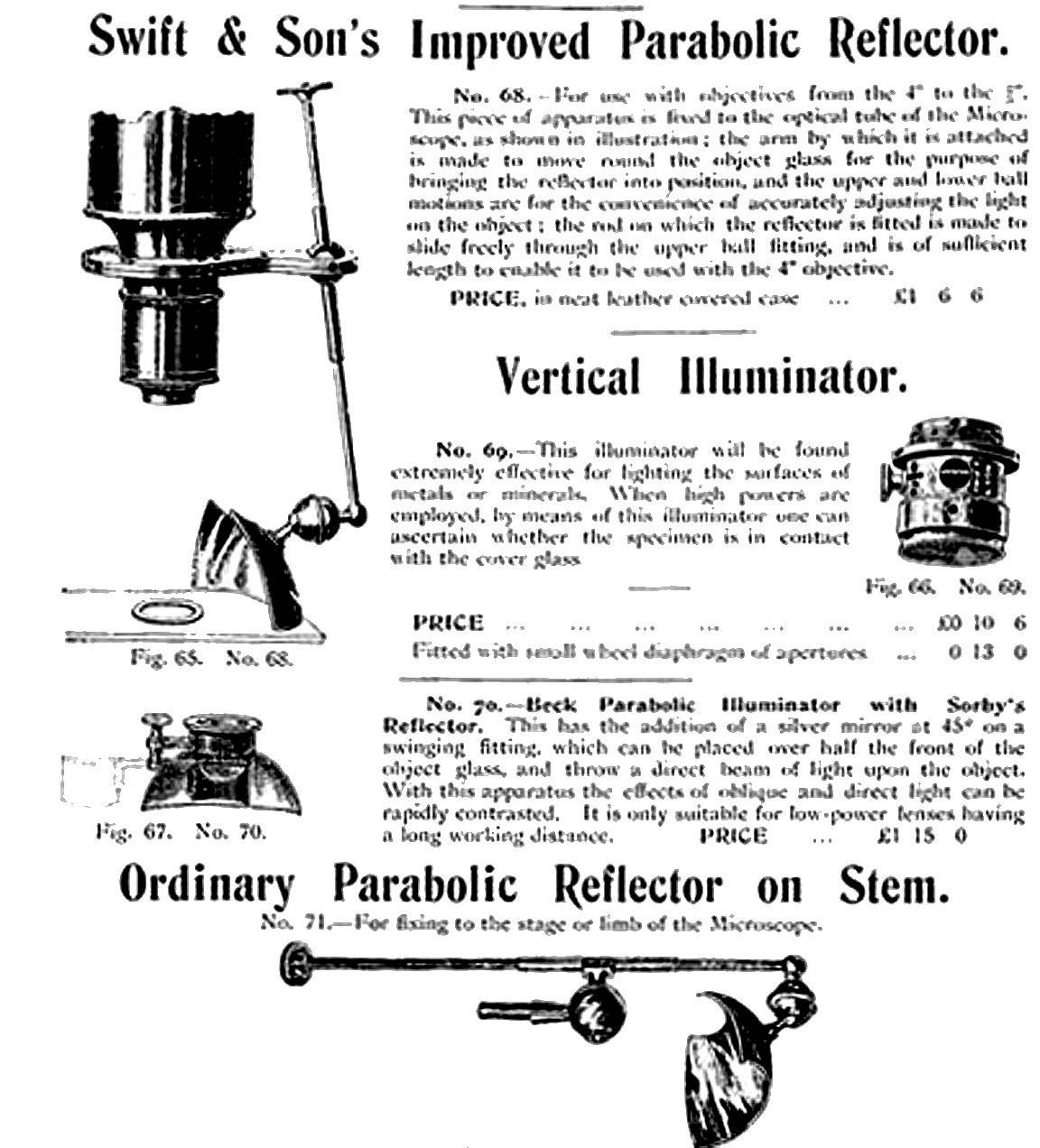 Another method of top lighting, similar to the use of a Lieberkuhn but not requiring light from beyond the specimen, is the use of a parabolic hemi-reflector. This can take the form of an attachment to the objective or nosepiece, or be separately mounted to be placed up against the back or side of the objective. Light is directed from the side or front of the microscope, and reflected downward upon the specimen. A modification of this device was, in addition to the large reflector, the addition of a tiny extra swing-in prism or reflector that can be brought near the bottom of the objective to reflect light downward, but again, this technique is not useful with short focal lengths.
Another method of top lighting, similar to the use of a Lieberkuhn but not requiring light from beyond the specimen, is the use of a parabolic hemi-reflector. This can take the form of an attachment to the objective or nosepiece, or be separately mounted to be placed up against the back or side of the objective. Light is directed from the side or front of the microscope, and reflected downward upon the specimen. A modification of this device was, in addition to the large reflector, the addition of a tiny extra swing-in prism or reflector that can be brought near the bottom of the objective to reflect light downward, but again, this technique is not useful with short focal lengths.
Vertical illuminators, first developed in the 19th century, are used for illumination of solid or opaque objects with higher power objectives. Although with low power, top-illumination from the side can suffice, as the magnification increases and the focal length shortens, external light cannot easily be directed onto the top of an opaque specimen. The vertical illuminators allow the light to come directly down onto the specimen from above through the objective, by reflecting incoming light off a coverslip or prism at an angle which at the same time allows the reflected light to pass back up in the opposite direction reaching the eyepiece. With the coverslip type the reflected light goes up through the coverslip; with the tiny prism, it is so small, light is able to pass up the illuminator around it, but not through its center. Another variation was to place a longer prism at the edge of the field and allow the light to pass back up through the remaining field.
Later on, another type was developed which directed light downward around the outside edge of specially designed concentric episcopic objectives. Providing illumination similar to the way Lieberkuhns do, these objectives do not suffer from the disadvantage of the Lieberkuhn which require the subject to be small, since the light in these special objectives originates from above. The chief disadvantage of this type is the dramatically higher cost of producing such objectives.
HISTORY OF VERTICAL ILLUMINATORS:
Although episcopic illumination(illumination from above an object), originated with the very first microscopes, the apparatus we now call vertical illuminators originated in the 19th century. The first idea for the use of illumination through the objective, as opposed to from outside of the objective, apparently originated with Ridell about 1865 or even earlier. It was apparently not put to practical use or produced commercially until H.L. Smith of Kenyon College published his article* in 1865. Smith's original illuminator, constructed at his request by Wales, used a reflective speculum within the illuminator to reflect light coming in from a hole on the side of the illuminator, down through the objective lenses, which was then reflected back up, reaching the eyepiece. This apparatus also had a wheel of diaphragms to regulate the aperture of light coming into it. Smith's apparatus, like that of Zeiss (see below), illuminated the object from one side of the illuminator, a semi-oblique illumination. He tried the coverslip method as in the Smith & Beck illuminator(see below), but felt the directly vertical illumination inferior to the oblique illumination. The is not surprising, as he was studying objects which were not completely flat, i.e. diatoms. Despite Smith's objections, the coverslip method became much more popular and Smith, Beck and Beck patented a very simple coverslip vertical illuminator (at that time called an opaque or opake illuminator), in the mid-1860's.
The prism-based illuminator, apparently first contructed by Robert Tolles, was first reported in the JRMS of 1880. This model had much in common with H.L.Smith's illuminator but instead of a speculum it used a small prism. Like Smith's, it could be rotated and pushed in and out of the field. Unlike H.L. Smith's device, it was built-in to the objective rather than in a separate device above the objective. In the Tolles device the prism was placed above the most distal optical elements of the objective. The prism replaced the speculum type and competed in popularity with the coverslip model. The prism-based model was much more expensive to make, and so its cost likely also limited its popularity, so the coverslip type remained much more common.
In 1881, Tighlmann reported a vertical illuminator with variable apertures, in a different configuration than Smith's. In this model, a cylinder with various different size apertures rotated around the hole in the body of the illuminator to regulate the diameter of the light beam entering the device. Complaints were raised about this device in that making the adjustment was not as delicate as required for high power work so it was not popular. A similar design was produced by Meyerowitz for their Bulloch-Myerowitz microscopes of the late 19th century.
Starting in the 1920's much more sophisticated vertical illuminators, such as the Watson-Conrady Illuminator. This device carries the idea to a higher level of sophistication, with provision for Kohler illumination, with integrated condensing lenses, iris diaphragms, and electic lighting all built in. Not only did this make the illumination more appropriate, but because the light was integrated into the illuminator, it eliminated the need to move the light source every time the focus was changed or the objective changed when a traditional tube focusing arrangement was used.
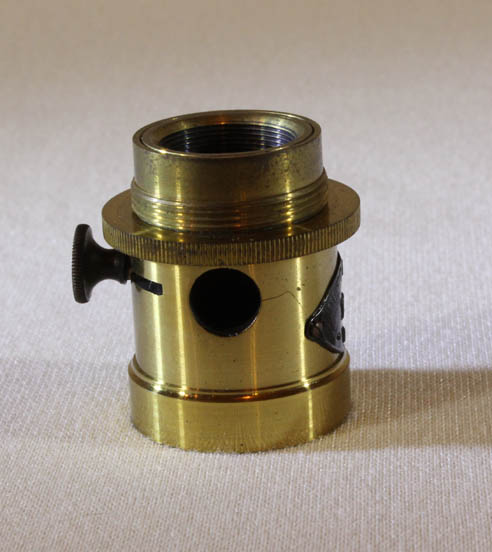 This is one of the earliest types of vertical illuminators, first patented and sold by Smith and Beck(1847-1867). It was first produced in the 1860's though it is not listed in the 1866 catalog. It uses a replaceable round coverslip (cover glass) as a reflector, while at the same time light is allowed to travel back across it to the eyepiece. In this condition, the objective acts both as a condensor and an objective. This is the very basic model with no additional components. Later refinements included a variable diaphragm to regulate the diameter of the light beam. Other refinements followed. This design, with improvements, stood the test of time and, with modifications, continued to be made well into the 20th century.
This is one of the earliest types of vertical illuminators, first patented and sold by Smith and Beck(1847-1867). It was first produced in the 1860's though it is not listed in the 1866 catalog. It uses a replaceable round coverslip (cover glass) as a reflector, while at the same time light is allowed to travel back across it to the eyepiece. In this condition, the objective acts both as a condensor and an objective. This is the very basic model with no additional components. Later refinements included a variable diaphragm to regulate the diameter of the light beam. Other refinements followed. This design, with improvements, stood the test of time and, with modifications, continued to be made well into the 20th century.
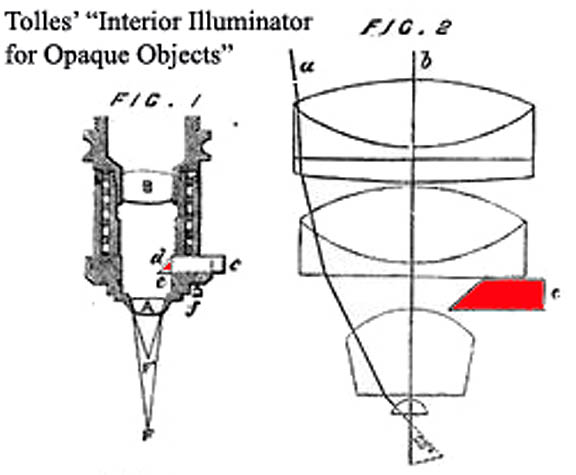 Tolles' 'Interior Illuminator for Opaque Objects' was announced in the JRMS in 1881. Using a prism instead of a speculum, and placing the prism inside the objective, above the distal element, it was claimed to be superior method of illumination. The extra expense of having a special objective as opposed to a single illuminator for all objectives, likely contributed to its lack of popularity.
Tolles' 'Interior Illuminator for Opaque Objects' was announced in the JRMS in 1881. Using a prism instead of a speculum, and placing the prism inside the objective, above the distal element, it was claimed to be superior method of illumination. The extra expense of having a special objective as opposed to a single illuminator for all objectives, likely contributed to its lack of popularity.
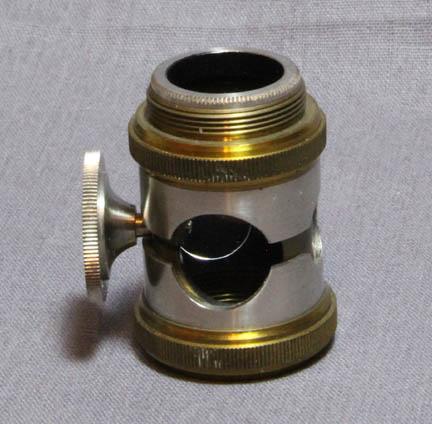 Also in 1881, Tighlmann reported in the JRMS, a vertical illuminator with variable apertures. In this model, a cylinder with various different size apertures rotated around the hole in the body of the illuminator to regulate the diameter of the light beam entering the device. Complaints were raised about this device in that making the adjustment was not as delicate as required for high power work so it was not popular. A similar design was produced by Meyerowitz for their Bulloch-Myerowitz microscopes of the late 19th century, and that is the model shown here to the left.
Also in 1881, Tighlmann reported in the JRMS, a vertical illuminator with variable apertures. In this model, a cylinder with various different size apertures rotated around the hole in the body of the illuminator to regulate the diameter of the light beam entering the device. Complaints were raised about this device in that making the adjustment was not as delicate as required for high power work so it was not popular. A similar design was produced by Meyerowitz for their Bulloch-Myerowitz microscopes of the late 19th century, and that is the model shown here to the left.
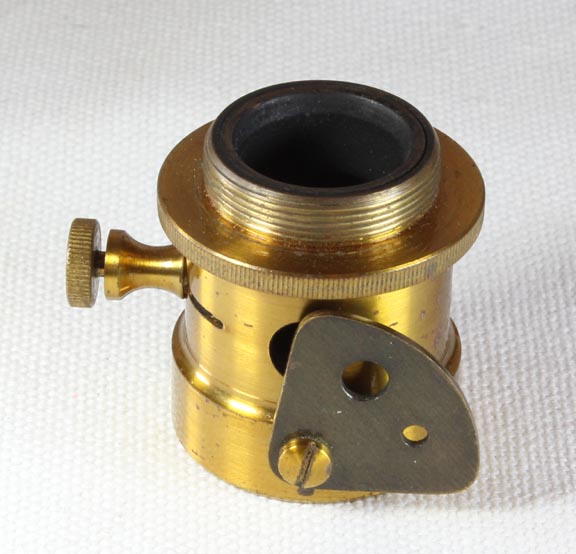 This illuminator was first announced in the 1885 JRMS, p 522. It is nearly identical to the simpler Smith Beck Illuminator noted above, but includes a fitting to vary the aperture to the size of one of the holes, or alternatively, the edge of the blackened brass piece can be positioned over the hole in the illuminator to create a variety of patterns of illumination. This form remained available for many years.
This illuminator was first announced in the 1885 JRMS, p 522. It is nearly identical to the simpler Smith Beck Illuminator noted above, but includes a fitting to vary the aperture to the size of one of the holes, or alternatively, the edge of the blackened brass piece can be positioned over the hole in the illuminator to create a variety of patterns of illumination. This form remained available for many years.
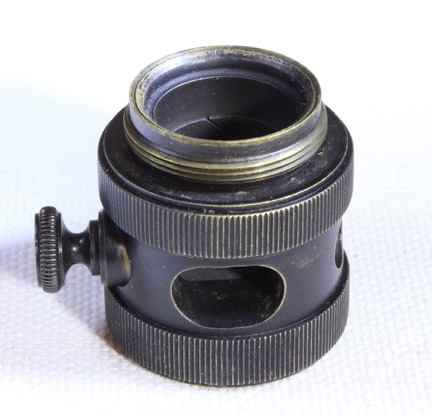 A later illuminator, by Zeiss utilizes a prism as the reflector. The design of this illuminator incorporates a relatively long prism so some of the light reflected back from the object is blocked. Later on, smaller prisms allowed more reflected light to enter the field of view, as in the prism optical illuminators Watson produced. The Watson 'Combined Vertical Illuminator' also used a small prism. This illuminator was first introduced in the Zeiss catalog of 1895 and first reported in the JRMS in 1896. It continued to be until at least 1939. The basic version had no integrated iris or provision for dark ground illumination. At some point another model started to be produced with a slot which was for tin inserts providing dark ground illumination.
A later illuminator, by Zeiss utilizes a prism as the reflector. The design of this illuminator incorporates a relatively long prism so some of the light reflected back from the object is blocked. Later on, smaller prisms allowed more reflected light to enter the field of view, as in the prism optical illuminators Watson produced. The Watson 'Combined Vertical Illuminator' also used a small prism. This illuminator was first introduced in the Zeiss catalog of 1895 and first reported in the JRMS in 1896. It continued to be until at least 1939. The basic version had no integrated iris or provision for dark ground illumination. At some point another model started to be produced with a slot which was for tin inserts providing dark ground illumination.
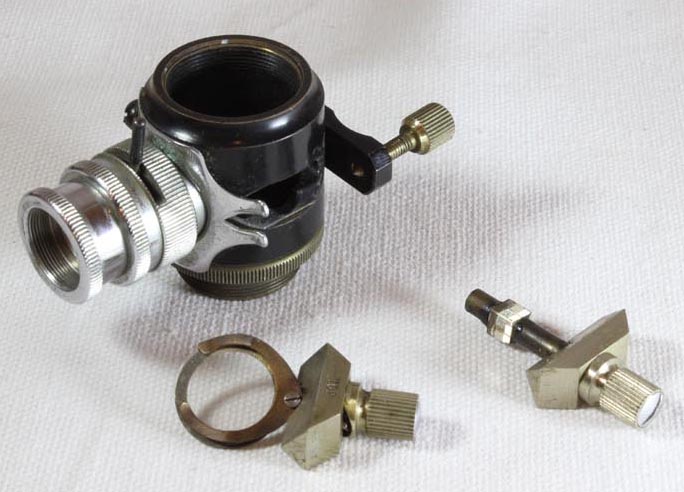 Watson's 'Combined Vertical Illuminator' set, in a signed case, provides the option of a tiny prism or coverslip for reflecting the illuminating light beam. It also had a condensing lens and an iris diaphragm to regulate the light directed through it. The Watson 'Combined Vertical Illuminator' was first offered by Watson in the 1920's after 1921, and is shown in the 1926 catalog (thanks to Dr Joe Zeligs for this information).
Watson's 'Combined Vertical Illuminator' set, in a signed case, provides the option of a tiny prism or coverslip for reflecting the illuminating light beam. It also had a condensing lens and an iris diaphragm to regulate the light directed through it. The Watson 'Combined Vertical Illuminator' was first offered by Watson in the 1920's after 1921, and is shown in the 1926 catalog (thanks to Dr Joe Zeligs for this information).
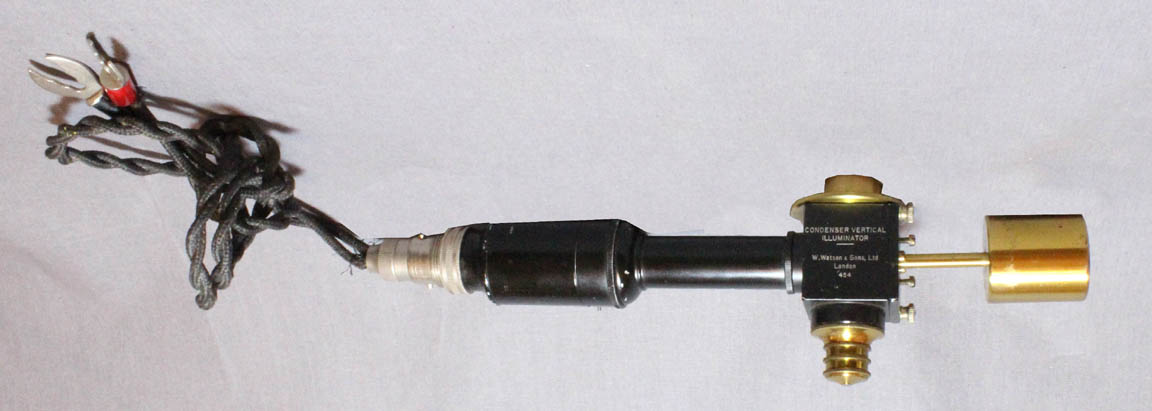 Finally a 'Watson-Conrady Condensor Vertical Illuminator' with built-in light source is also present in this collection. It could be powered by a battery, or with house current, with a resistance device. In addition to a lens system, it had two iris diaphragms making Kohler illumination possible. Furthermore, because the light source was intrinsic to the illuminator, it could be used with a tube-focusing microscope without the annoyance of having to move the light source to adjust for changes in focus or objective. This set the standard for modern vertical illuminators, providing Kohler illumination in the vertical illumination configuration. The Watson-Conrady Condenser Vertical Illuminator was offered from about 1923 through the 1940's. Reichert and others supplied similar illuminators during the 2nd quarter of the 20th century.
Finally a 'Watson-Conrady Condensor Vertical Illuminator' with built-in light source is also present in this collection. It could be powered by a battery, or with house current, with a resistance device. In addition to a lens system, it had two iris diaphragms making Kohler illumination possible. Furthermore, because the light source was intrinsic to the illuminator, it could be used with a tube-focusing microscope without the annoyance of having to move the light source to adjust for changes in focus or objective. This set the standard for modern vertical illuminators, providing Kohler illumination in the vertical illumination configuration. The Watson-Conrady Condenser Vertical Illuminator was offered from about 1923 through the 1940's. Reichert and others supplied similar illuminators during the 2nd quarter of the 20th century.
Modern vertical illuminators are similar to the Watson-Conrady model except instead of a coverslip as reflector, they use a beam-splitting prism, which allows highly reflected light to illuminate the object while at the same time allowing most of the light bouncing off the object to pass through the prism vertically towards the eyepiece.
Modern microscopes providing vertical illumination as well as those providing 'Epi' illumination in this collection include an Olympus Vanox with vertical illumination through the objectives themselves, and a Wild Epi-illumination system which uses the concentric type of illumination. Modern vertical illuminators are similar to the Watson-Conrady model except instead of a coverslip as reflector, they use a beam-splitting prism, which allows highly reflected light to illuminate the object while at the same time allowing most of the light bouncing off the object to pass through vertically towards the eyepiece.
*Smith, H.L. Art. XXIV.-On a new Illuminator for Opaque objects under high powers of the Microscope; Am J of Science and Arts Second series. Vol XL July-Nov 1865 pp238-41.
 In order to visualize an opaque specimen in a microscope, it must be illuminated from above, rather than below. This kind of illumination can be accomplished several ways. The simplest and earliest method was simply illumination from the side of the object. This was how objects were originally viewed with, e.g. tripod microscopes, until the practice of using transmitted light was used. This is adequate with objectives of long focal length and low power, that is, 10X and lower power objectives, which with a 10X eyepiece provides a maximum magnification of about 100X, however as the power increases (and focal length decreases), it becomes more and more difficult to uniformly illuminate a specimen with ambient or even directed light.
In order to visualize an opaque specimen in a microscope, it must be illuminated from above, rather than below. This kind of illumination can be accomplished several ways. The simplest and earliest method was simply illumination from the side of the object. This was how objects were originally viewed with, e.g. tripod microscopes, until the practice of using transmitted light was used. This is adequate with objectives of long focal length and low power, that is, 10X and lower power objectives, which with a 10X eyepiece provides a maximum magnification of about 100X, however as the power increases (and focal length decreases), it becomes more and more difficult to uniformly illuminate a specimen with ambient or even directed light. A lens between the light source and the object being studied can be used to concentrate the light. Robert Hooke was one of the first to use this method. He used a hollow sphere of glass filled with water and another planoconvex lens; this lens became knowns as a bullseye condenser.
A lens between the light source and the object being studied can be used to concentrate the light. Robert Hooke was one of the first to use this method. He used a hollow sphere of glass filled with water and another planoconvex lens; this lens became knowns as a bullseye condenser. The 'bullseye' condenser, a large diameter plano-convex lens was in use for this purpose from the late 1700's onward. It could be supplied as a stand-alone lens as a 'bench' condenser, or when smaller, attached directly to the microscope via the stage, a ring around the optical tube or an extension rod attached to the limb.
The 'bullseye' condenser, a large diameter plano-convex lens was in use for this purpose from the late 1700's onward. It could be supplied as a stand-alone lens as a 'bench' condenser, or when smaller, attached directly to the microscope via the stage, a ring around the optical tube or an extension rod attached to the limb. 
 With moderate powers, something more than an ordinary light source from above or the side is needed. The first attempt to do this was with the use of a Lieberkuhn reflector, initially suggested by Descartes, but first known to be used on a microscope by Van Leewoenhoek about 1670, and Pierre Van Musshenbroek, as pictured in his Essai de Physique published in 1739. Although this type of reflector continued to be used by Van Leeuwoenhoek in the 2nd quarter of the 18th century, it was reintroduced and popularized in the mid to late 1700's by Johann Lieberkuhn, hence his name became associated with the device. It was soon provided with most models of pre-achromatic microscopes such as the Culpeper type,Cuff type, etc. With the development of the achromatic microscope, Lieberkuhns continued to be supplied, usually purpose-made for each objective. With this device, the light source from beyond the object passes around it and is reflected back down upon it by a polished mirrored parabolic surface that surrounds the objective. The chief limitation of this technique is that the object must be small enough to allow the light to pass around it, and this is often not the case, especially for metal samples. Once brass nosepieces became common, removeable Lieberkuhn reflectors were made to fit around the nosepiece, with the reflecting portion sitting in front of the objective. As time passed, it was recognized that different sizes and curvatures were useful for different magnifications; higher power objectives required a Lieberkuhn of smaller diameter and lesser curvature. With the advent of achromatic objectives in the 1840's individual Lieberkuhns were often supplied for each objective, fitting over each objective itself rather than the nosepiece above.
With moderate powers, something more than an ordinary light source from above or the side is needed. The first attempt to do this was with the use of a Lieberkuhn reflector, initially suggested by Descartes, but first known to be used on a microscope by Van Leewoenhoek about 1670, and Pierre Van Musshenbroek, as pictured in his Essai de Physique published in 1739. Although this type of reflector continued to be used by Van Leeuwoenhoek in the 2nd quarter of the 18th century, it was reintroduced and popularized in the mid to late 1700's by Johann Lieberkuhn, hence his name became associated with the device. It was soon provided with most models of pre-achromatic microscopes such as the Culpeper type,Cuff type, etc. With the development of the achromatic microscope, Lieberkuhns continued to be supplied, usually purpose-made for each objective. With this device, the light source from beyond the object passes around it and is reflected back down upon it by a polished mirrored parabolic surface that surrounds the objective. The chief limitation of this technique is that the object must be small enough to allow the light to pass around it, and this is often not the case, especially for metal samples. Once brass nosepieces became common, removeable Lieberkuhn reflectors were made to fit around the nosepiece, with the reflecting portion sitting in front of the objective. As time passed, it was recognized that different sizes and curvatures were useful for different magnifications; higher power objectives required a Lieberkuhn of smaller diameter and lesser curvature. With the advent of achromatic objectives in the 1840's individual Lieberkuhns were often supplied for each objective, fitting over each objective itself rather than the nosepiece above.  Another method of top lighting, similar to the use of a Lieberkuhn but not requiring light from beyond the specimen, is the use of a parabolic hemi-reflector. This can take the form of an attachment to the objective or nosepiece, or be separately mounted to be placed up against the back or side of the objective. Light is directed from the side or front of the microscope, and reflected downward upon the specimen. A modification of this device was, in addition to the large reflector, the addition of a tiny extra swing-in prism or reflector that can be brought near the bottom of the objective to reflect light downward, but again, this technique is not useful with short focal lengths.
Another method of top lighting, similar to the use of a Lieberkuhn but not requiring light from beyond the specimen, is the use of a parabolic hemi-reflector. This can take the form of an attachment to the objective or nosepiece, or be separately mounted to be placed up against the back or side of the objective. Light is directed from the side or front of the microscope, and reflected downward upon the specimen. A modification of this device was, in addition to the large reflector, the addition of a tiny extra swing-in prism or reflector that can be brought near the bottom of the objective to reflect light downward, but again, this technique is not useful with short focal lengths.  This is one of the earliest types of vertical illuminators, first patented and sold by Smith and Beck(1847-1867). It was first produced in the 1860's though it is not listed in the 1866 catalog. It uses a replaceable round coverslip (cover glass) as a reflector, while at the same time light is allowed to travel back across it to the eyepiece. In this condition, the objective acts both as a condensor and an objective. This is the very basic model with no additional components. Later refinements included a variable diaphragm to regulate the diameter of the light beam. Other refinements followed. This design, with improvements, stood the test of time and, with modifications, continued to be made well into the 20th century.
This is one of the earliest types of vertical illuminators, first patented and sold by Smith and Beck(1847-1867). It was first produced in the 1860's though it is not listed in the 1866 catalog. It uses a replaceable round coverslip (cover glass) as a reflector, while at the same time light is allowed to travel back across it to the eyepiece. In this condition, the objective acts both as a condensor and an objective. This is the very basic model with no additional components. Later refinements included a variable diaphragm to regulate the diameter of the light beam. Other refinements followed. This design, with improvements, stood the test of time and, with modifications, continued to be made well into the 20th century. Tolles' 'Interior Illuminator for Opaque Objects' was announced in the JRMS in 1881. Using a prism instead of a speculum, and placing the prism inside the objective, above the distal element, it was claimed to be superior method of illumination. The extra expense of having a special objective as opposed to a single illuminator for all objectives, likely contributed to its lack of popularity.
Tolles' 'Interior Illuminator for Opaque Objects' was announced in the JRMS in 1881. Using a prism instead of a speculum, and placing the prism inside the objective, above the distal element, it was claimed to be superior method of illumination. The extra expense of having a special objective as opposed to a single illuminator for all objectives, likely contributed to its lack of popularity.  Also in 1881, Tighlmann reported in the JRMS, a vertical illuminator with variable apertures. In this model, a cylinder with various different size apertures rotated around the hole in the body of the illuminator to regulate the diameter of the light beam entering the device. Complaints were raised about this device in that making the adjustment was not as delicate as required for high power work so it was not popular. A similar design was produced by Meyerowitz for their Bulloch-Myerowitz microscopes of the late 19th century, and that is the model shown here to the left.
Also in 1881, Tighlmann reported in the JRMS, a vertical illuminator with variable apertures. In this model, a cylinder with various different size apertures rotated around the hole in the body of the illuminator to regulate the diameter of the light beam entering the device. Complaints were raised about this device in that making the adjustment was not as delicate as required for high power work so it was not popular. A similar design was produced by Meyerowitz for their Bulloch-Myerowitz microscopes of the late 19th century, and that is the model shown here to the left. This illuminator was first announced in the 1885 JRMS, p 522. It is nearly identical to the simpler Smith Beck Illuminator noted above, but includes a fitting to vary the aperture to the size of one of the holes, or alternatively, the edge of the blackened brass piece can be positioned over the hole in the illuminator to create a variety of patterns of illumination. This form remained available for many years.
This illuminator was first announced in the 1885 JRMS, p 522. It is nearly identical to the simpler Smith Beck Illuminator noted above, but includes a fitting to vary the aperture to the size of one of the holes, or alternatively, the edge of the blackened brass piece can be positioned over the hole in the illuminator to create a variety of patterns of illumination. This form remained available for many years.
 A later illuminator, by Zeiss utilizes a prism as the reflector. The design of this illuminator incorporates a relatively long prism so some of the light reflected back from the object is blocked. Later on, smaller prisms allowed more reflected light to enter the field of view, as in the prism optical illuminators Watson produced. The Watson 'Combined Vertical Illuminator' also used a small prism. This illuminator was first introduced in the Zeiss catalog of 1895 and first reported in the JRMS in 1896. It continued to be until at least 1939. The basic version had no integrated iris or provision for dark ground illumination. At some point another model started to be produced with a slot which was for tin inserts providing dark ground illumination.
A later illuminator, by Zeiss utilizes a prism as the reflector. The design of this illuminator incorporates a relatively long prism so some of the light reflected back from the object is blocked. Later on, smaller prisms allowed more reflected light to enter the field of view, as in the prism optical illuminators Watson produced. The Watson 'Combined Vertical Illuminator' also used a small prism. This illuminator was first introduced in the Zeiss catalog of 1895 and first reported in the JRMS in 1896. It continued to be until at least 1939. The basic version had no integrated iris or provision for dark ground illumination. At some point another model started to be produced with a slot which was for tin inserts providing dark ground illumination.  Watson's 'Combined Vertical Illuminator' set, in a signed case, provides the option of a tiny prism or coverslip for reflecting the illuminating light beam. It also had a condensing lens and an iris diaphragm to regulate the light directed through it. The Watson 'Combined Vertical Illuminator' was first offered by Watson in the 1920's after 1921, and is shown in the 1926 catalog (thanks to Dr Joe Zeligs for this information).
Watson's 'Combined Vertical Illuminator' set, in a signed case, provides the option of a tiny prism or coverslip for reflecting the illuminating light beam. It also had a condensing lens and an iris diaphragm to regulate the light directed through it. The Watson 'Combined Vertical Illuminator' was first offered by Watson in the 1920's after 1921, and is shown in the 1926 catalog (thanks to Dr Joe Zeligs for this information). Finally a 'Watson-Conrady Condensor Vertical Illuminator' with built-in light source is also present in this collection. It could be powered by a battery, or with house current, with a resistance device. In addition to a lens system, it had two iris diaphragms making Kohler illumination possible. Furthermore, because the light source was intrinsic to the illuminator, it could be used with a tube-focusing microscope without the annoyance of having to move the light source to adjust for changes in focus or objective. This set the standard for modern vertical illuminators, providing Kohler illumination in the vertical illumination configuration. The Watson-Conrady Condenser Vertical Illuminator was offered from about 1923 through the 1940's. Reichert and others supplied similar illuminators during the 2nd quarter of the 20th century.
Finally a 'Watson-Conrady Condensor Vertical Illuminator' with built-in light source is also present in this collection. It could be powered by a battery, or with house current, with a resistance device. In addition to a lens system, it had two iris diaphragms making Kohler illumination possible. Furthermore, because the light source was intrinsic to the illuminator, it could be used with a tube-focusing microscope without the annoyance of having to move the light source to adjust for changes in focus or objective. This set the standard for modern vertical illuminators, providing Kohler illumination in the vertical illumination configuration. The Watson-Conrady Condenser Vertical Illuminator was offered from about 1923 through the 1940's. Reichert and others supplied similar illuminators during the 2nd quarter of the 20th century.